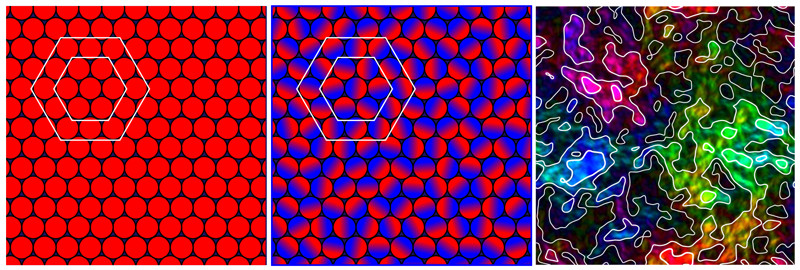Active particles can form two-dimensional crystals that are different from those formed by passive particles in equilibrium, showing extreme spontaneous deformation at large scales without melting.

Two-dimensional crystals have long fascinated theorists, but there exist many experimental realizations of them, such as electrons at the surface of Helium and colloidal particles with repulsive pair interactions confined at an interface, even though they are rather fragile and only exhibit quasi long-range positional order due to fluctuations.
The theorists’ fascination largely lies in the tour-de-force found in a series of papers published in the 1970s by “Kosterlitz, Thouless, Halperin, Nelson, and Young”. KTHNY theory demonstrates that 2D crystals do have long-range order, but for the orientation of the bonds linking neighboring particles, so that the melting of 2D crystals can occur in two steps. When continuous, these two transitions are of the Kosterlitz-Thouless type, i.e. present infinite-order singularities. The first transition marks the loss of positional order due to the unbinding of pairs of dislocations, leaving a phase with only quasi-long-range bond order. KTHNY theory also predicts that the decay exponent characterizing the quasi-long-range positional order in the crystal, which increases continuously with temperature, cannot be larger than 1/3.
KTHNY theory is not expected to hold out of thermal equilibrium, although some recent papers makes this claim in the context of ‘active’ particles, i.e. particles embodied with an intrinsic physical axis along which they move, and which thus cannot turn instantaneously.
In a recent Physical Review Letters [1] paper highlighted in Physics Magazine, Hugues Chaté and colleagues from Suzhou, China, demonstrated that 2D crystals of active particles can in fact exhibit extremely large deformation without melting, with the exponent taking essentially unbounded values. This is a stunning proof that KTHNY theory does not hold out of equilibrium, at least at the quantitative level.
Chaté et al. trace back the possibility of large deformations to the time-persistence of the intrinsic axis of active particles. Thus a crystal of passive particles that would be subjected to persistent fluctuations introduced by an ‘active bath’ will also be extremely deformable and yet deprived of free defects.
These results could find applications in macroscopic mechanical metamaterials made of active elements that would resist large deformations without affecting the material’s integrity.
Reference:
[1] Extreme Spontaneous Deformations of Active Crystals
Xia-qing Shi, Fu Cheng, and Hugues Chaté Phys. Rev. Lett. 131 (2023) 108301 – Published 5 September 2023
Contact CEA : Hugues Chaté SPEC/SPHYNX.





